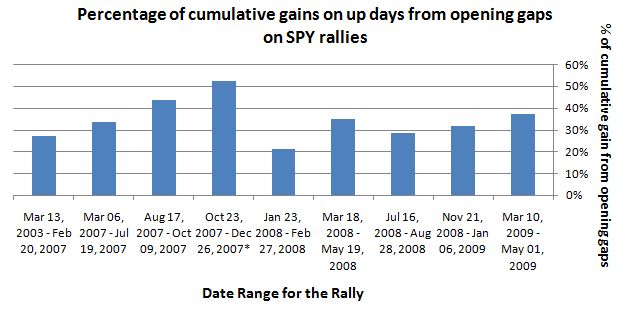Up Gaps Are An Increasing Share of Stock Market Gains
By Dr. Duru written for One-Twenty
May 4, 2009
I have read repeated claims that a large portion of the gains during this latest bear market rally in stocks have occurred on up gaps. The implication is that a rally driven by large up gaps is unstable and perhaps even being manipulated by the small numbers of players who jostle prices in the low volumes of pre-market trading. I have yet to see supporting data. Since I could not find any, I decided, in usual fashion, to take a look for myself. After examining the data, it does indeed appear that as the bear market continues up gaps represent an increasing percentage of stock market gains during rallies. However, today's percentages remain lower than those from the end of the last bull market and the beginning of this bear market.
I define an up gap as any open above the previous trading day's close. (Note that TradingMarkets.com offers a more refined definition: an up gap is an open above the previous trading day's high and a "lap up" is an open above the previous trading day's close). To measure gaps in the stock market I use SPY, the SPDRs S&P 500 ETF. SPY provides a more accurate view of the stock market open than the S&P 500. For comparative purposes, I only analyze the up gaps from periods where the S&P 500 (SPY) is rallying. The one exception is from Oct 23, 2007 - Dec 26, 2007 which technically encompasses three short rallies; I have combined these dates for simplicity and convenience. For each rally, I sum up the cumulative total of gains from ALL days that ended with a gain. This means I exclude from the analysis all days that end in a loss from the previous trading day. I use this cumulative method in order to capture the impact of any and all up gaps. I distinguish between up days which begin with a gap up and days that do not. Thus, the table below quantifies two measures: 1) the second column, labeled "Any up day," quantifies the percentage of cumulative gains delivered by up gaps - if the open is negative, I zero out the gap's contribution to the day's gain; 2) the third column, labeled "Up days with opening gaps," quantifies the percentage of cumulative gains delivered by up gaps ONLY on trading days that start with an up gap. In both cases, the up gap is capped at the total gain on the day. I only include the third column for reference. Finally, I include some color-coding: 1) the first yellow row marks the current rally; 2) The second yellow row marks the comparable seven week period off the last bear market lows in 2003; and 3) the green rows mark distinct rallies during the last bull market punctuated by the last two corrections before it ended.

The chart below shows this same data in graphical form.

Here are my observations (without estimating any measures of statistical significance):
- Up gaps had no more impact on stock market gains during the first seven weeks off the bear market lows in 2003 than they had over the entire course of the last bull market.
- As the last bull market came to an end, up gaps became a rapidly increasing portion of market gains.
- The impact of up gaps finally peaked during the bear market's first seven weeks or so.
- Since the peak from #2, the general trend has been upward for the impact of up gaps on stock market gains, but today's numbers are equivalent to the first bear market rally the followed the collapse of Bear Stearns.
I am even more intrigued by the higher levels of impact seen during the end of the last bull market and the beginning of this bear market. I did not take a look back at even older historical data because I cannot currently make a good case that previous bull markets provide comparable points of analyses for these kinds of data. Perhaps we should watch out for increasing contributions of up gaps during the NEXT bull market. For some reference, I did calculate up gap contribution for the bulk of the last bear market, Jan 02, 2001 to Dec 31, 2002: 29% on any up day, 41% on up days beginning with a gap up.
(Click here for suggestions on how to trade opening gaps by Dave Landry. Trader Mike does a review of "Mastering the Trade" by John Carter which includes additional tips on fading gaps.)
Be careful out there!
Full disclosure: long SDS. For other disclaimers click here.